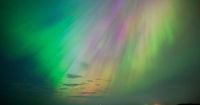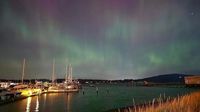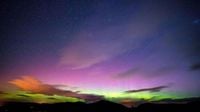Washington State is gearing up for a stunning celestial display as a strong Geomagnetic Storm Watch was issued on Tuesday morning, April 15, 2025, by NOAA's Space Weather Prediction Center. This alert indicates a significant chance to see the aurora borealis across western Washington, with the spectacle expected to extend down into Oregon and eastward into the lower Midwest.
The excitement stems from multiple coronal mass ejections (CMEs) that erupted from the sun on Sunday, April 13, 2025. These bursts of highly charged solar plasma and magnetic field are predicted to impact the Earth's upper atmosphere on Tuesday night into Wednesday morning. The aurora may be visible as early as Tuesday night, April 15, and could continue into the early hours of Wednesday, April 16.
For the best viewing experience, experts recommend heading out of urban areas to escape light pollution and looking northward. Cellphone cameras, which can often capture the lights better than the naked eye, should be used to scan the sky. Despite a forecast of mostly clear skies, pockets of fog and low clouds may develop around the Puget Sound Lowlands, potentially impairing visibility in some neighborhoods.
Just before 11 a.m. PDT on Tuesday, NOAA's SWPC reported that a shock associated with the approaching CMEs had arrived, signaling the beginning of geomagnetic storm activity. However, this activity is expected to weaken into Wednesday night, April 16, 2025.
The aurora borealis is a phenomenon that originates about 93 million miles away on the sun's surface. When sunspot clusters erupt, they can create solar storms that emit energy in the form of flares and plasma expulsions known as CMEs. These CMEs travel through space and interact with the Earth's atmosphere, causing a geomagnetic storm that results in the beautiful display of lights.
NOAA's Space Weather Prediction Center has developed a scale to monitor these disturbances, similar to the scales used for hurricanes and tornadoes. The Kp index measures the horizontal movement in the Earth’s magnetic field over three-hour intervals, ranging from 0 (calm) to 9 (extreme storm). For instance, during a severe geomagnetic storm in May 2024, the Kp index reached between 8 and 9.
In addition to the Kp index, NOAA also uses the G scale to measure the overall impacts of geomagnetic storms on technology. This scale ranges from G1 to G5, with G5 representing the most severe storms. The last G5 storm was observed in May 2024, which resulted in auroras visible as far south as California and Florida.
Green northern lights are the most common sighting, caused by oxygen in the lower atmosphere reacting to changes in the magnetosphere. Red, blue, and purple hues are rarer and typically only visible during more intense solar storms. The spectacular aurora seen during the May 2024 storm showcased the full spectrum of colors, much to the delight of observers across the mid-latitudes.
As the anticipation builds, many Washingtonians are eager for another chance to witness the northern lights. Social media has played a significant role in documenting these celestial events, with photographers capturing the phenomenon multiple times a year and sharing their experiences online.
In Michigan, residents are also preparing for the potential visibility of the aurora. The Space Weather Prediction Center has issued a strong G3 geomagnetic storm watch, indicating that the northern lights could be seen in the Upper Peninsula and northern half of Lower Michigan. The highest Kp index is expected to occur between 2 a.m. and 11 a.m. on Wednesday, April 16, 2025.
However, clear skies will be essential for optimal viewing. Fortunately, forecasts suggest that cloud cover may clear across the Upper Peninsula and northern Lower Michigan, enhancing the chances of witnessing the aurora.
As the storm approaches, the potential for technological disruptions also looms. A G3 geomagnetic storm can lead to intermittent satellite and low-frequency radio navigation issues, and surface charging may occur on satellite components. NOAA warns that these effects could impact satellites in low-Earth orbit, necessitating adjustments for orientation problems.
In the UK, the Met Office has also issued a geomagnetic storm watch, predicting that the northern lights might be visible from northern parts of the country. The aurora is expected to be at normal background levels until the arrival of a Coronal Mass Ejection, likely later on Tuesday and continuing into Wednesday.
People in Scotland and Northern Ireland are particularly well-placed to catch a glimpse of the aurora, although cloud cover could limit visibility. The best chances for sightings in the UK will be from 9 p.m. to midnight on Tuesday night.
As the sun is currently in its solar maximum phase, the frequency of solar activity has increased, making aurora sightings more common. The last year has seen a noticeable uptick in the visibility of the northern lights from the UK, as solar activity continues to rise.
For those hoping to witness this natural wonder, it’s advisable to head to areas with minimal light pollution and to have a clear view of the sky. Taking photographs can also enhance the experience, as cameras can capture colors that may not be visible to the naked eye.
With the geomagnetic storm watch in effect and the excitement building, many across the affected regions are eagerly awaiting the chance to see the aurora borealis light up the night sky. Whether in Washington, Michigan, or the UK, the allure of the northern lights promises to captivate and inspire awe.









